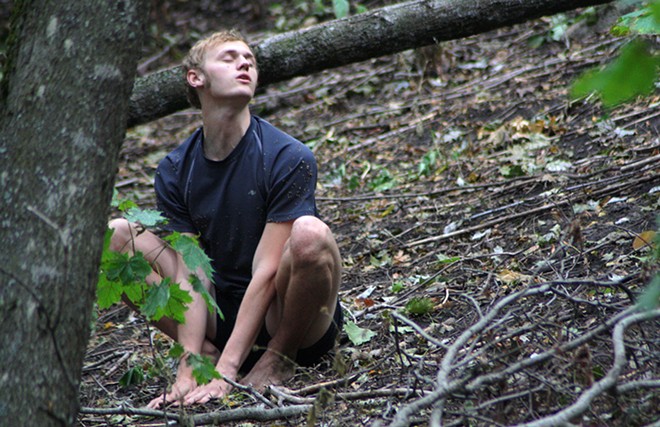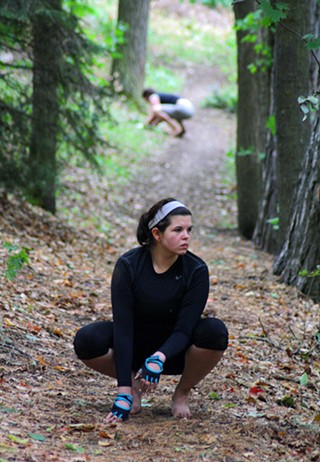In a grassy clearing at the University of Idaho's Shattuck Arboretum, 14 wild animals are taking a mid-afternoon nap. In the distance, a bell tower chimes 2 o'clock, and as if on cue, a black bear begins stirring. It rises slowly, lets out a growl and lumbers up a path before climbing into a tree. There, it waits as two humans, crawling on all fours, slowly pass by.
This isn't an experimental zoology study — it's an acting class. The black bear, 22-year-old Anthony Luna, is a senior majoring in theater performance.
"It's been a mythic class for, like, four years," says Luna, covered in dirt and grass after the class' second outdoor session.
The class, titled "Animals," is an elective offering in its 12th year at the university. In his syllabus, instructor David Lee-Painter describes the course as "a semester-long autodrama on steroids, without human communication skills."
Students drink from a plastic watering hole, run their "paws" through leafy piles of brush and howl on their haunches.
"If you're just to walk in, it looks completely insane," Lee-Painter says. Startled outsiders walking through the arboretum have thought so. Some have called police.
Walk like the animals
The method to the course's madness is to enhance an actor's primal instincts for the stage.
Lee-Painter learned of the animal acting technique from Jean Scharfenberg, an instructor at his graduate school, Illinois State University.
Scharfenberg learned the concept from famed acting instructor Lee Strasberg, whom she studied with the Actor's Studio. At Illinois State, "Animals" was a signature performance course, and students who took it include actors John Malkovich, Gary Sinise, Jane Lynch and others.
When Lee-Painter began teaching theater at University of Idaho in 1995, he used the technique as part of another course. Its popularity, however, led "Animals" to become a separate class, and Lee-Painter took the technique a step further by taking students outside.
After signing up for the class — offered this year to non-performance majors for the first time — students must select and research either a predatory or territorial animal.
Students then take a group trip to a Portland or Seattle-area zoo to observe their chosen animal, returning to the classroom to give presentations about why they chose their animals and what they hope to get from becoming them.
After that, students head outdoors for the next five or six weeks to forge their animal identities.
Students also use common materials to "make a baby" they'll carry with them while in character, raising the emotional stakes of the class and leading to confrontations where students can fight each other to the fake death.
Near its end, "Animals" moves back indoors, where students transfer animal work into human character work in scripted scenes and monologues.
Students are graded on their animal presentation and scripted work, as well as an end-of-semester reflection paper, but a large portion of the grade comes from participation in becoming their animal.
While Lee-Painter says "Animals" can certainly help students become better actors, he says the course is also about something bigger: being human.
"I think it has merit in terms of trying to be a more authentic human being," he says. "I think that that idea of becoming an animal just kind of takes away all the filters, right?"
The Dr. Doolittle of Acting
On the class' second day outdoors, Lee-Painter stands clad in a black long-sleeve shirt. The shirt reads "Animals 2012" on the front, and "canis lupus" — the scientific name of the gray wolf he once embodied many years ago — on the back.
"Get comfortable smackin' each other a little bit," he says, instructing his students as they practice gently — and sometimes not so gently — wrestling each other to the ground.
After wrestling, students spend 50 minutes exploring their habitats individually, looking for dens and becoming more comfortable in their animal bodies. Howls and yips echo into the breeze, sometimes drawing bemused expressions from students passing through the arboretum.
Lee-Painter warns students in his syllabus that the course is mentally and physically taxing, and by the time the day's class is over, it's easy to see why.
Actors crawl back to the grassy clearing to re-assume human form, exhausted, coughing and out of breath. The hair and clothing of nearly every student is covered in dirt, seeds, grass and leaves.
Some students have scrapes or scratches, and many of them seem relieved they only have to do it twice a week.
"It's an experience to make you value your humanity," says Luna, the aforementioned black bear. "Because the second I'm done with this class I'm hoppin' in the shower, and usin' Q-Tips with thumbs, and just having a great time." ♦
This article was provided by Murrow News Service, which is produced by journalism students at the Edward R. Murrow College of Communication at Washington State University.























